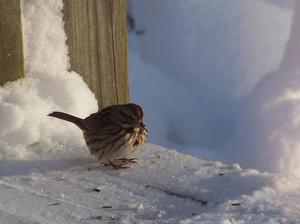Part VII: Capitalizing on Your Ecosystems
Larger acreage presents possibilities of multiple flourishing ecosystems.
Fields and open woodlands draw Wild Turkey. Curiously, in autumn I have spied on occasion a rafter slowly walking in single file on a circuitous path in the field in back of the greenhouses here at Quackin’ Grass. They nest on the ground in neighboring deciduous woods. If any among you have had the opportunity to observe wild Turkeys flying through the woodlands it is revelatory for as large as they are they are extraordinary and facile, surprisingly elegant.
Probably the most common sparrow ranging across North America is the Song Sparrow (see pic 1) with its unique and musical voice. Easily identified by the large central spot on its breast they are drawn to pastures normally nesting in nearby thickets not far off the ground. Brambles such as raspberries (Rubus) often thrive at the edges of fields. They feed 49 species including Wild Turkey, Veery, Orioles, and Blue Jays.
If you are fortunate enough to have an open sunny field and feel ambitious you can augment some of the bird-attracting composites (daisy-flowered perennials), grasses and goldenrods, if they aren’t already established, thereby increasing food sources for the feathered. One note of caution: in such a field there may be some birds that nest on the ground or in low branches if shrubs, too, are allowed to grow. It would be wise policy to mow such a field but once each year in middle to late fall when nesting is completed and birds have moved on.
Hawks (see pic 2) often prefer raising their young in open woodlands in large nests called aeries. High-flying hawks circling on warm columns of rising updrafts can often be spotted searching fields, pastures and backyards for rodents and snakes. Sharp-shinned Hawks with their featherless yellow legs and adept talons will predate smaller birds. When observing this carnage I cringe. But it is important to remember that they, too, are a part of this ecosystem. Deciduous trees in woodlands and at the edges of fields provide all manner of possibility to our feathered neighbors. Tree branches at a verge upon which Hawks and Owls set can be premium vantages from which to search the neighboring open field for prey. Vultures and American Crows will pick at carrion killed by vehicles or whose remains are abandoned by four-legged carnivores. I have watched Vultures alit on tree branches with partially opened wings after a rain literally “hanging out to dry” when the sun returns. Black and White Warblers live in open woodlands. They can be often spotted circling trunks and branches of trees at its edges in search of insects.
Dr. Craig informs us which trees feed the most number of species. Oaks, cherries, chestnuts, beeches, butternuts, dogwoods, red cedar, ashes and mountain ashes provide seeds, fruits and nuts. They also draw insects upon which so many species feed. These trees’ structures, too, provide nesting opportunities and cover. Other bird-attractive trees include common persimmon (Diospyros virginiana see pic 3), shagbark hickory (Carya ovata) and all maples (Acer).
Coniferous forests and groves alike are the preferred habitat to many birds as discussed in part V of this special series. The ecosystems of ponds and marshes offer possibilities for quite different species. Primitive-looking Great Blue Herons often nest at respectful distance from each other in open rookeries. Above wet, marshy and swampy expanses they utilize dead but still-standing trees as supports for their huge nests comprised of larger-caliper twigs and pieces of branch.
The early-arriving Red-winged Blackbirds, as much as Robins a sure sign of spring, prefer the open edges of marshes. These blackbirds choose bulrush, Scirpus lacustris, for nesting cover at marsh edge. Yellow Warblers which can sometimes be found hunting in one’s garden are denizens of swamp and stream edges. However, I have found these, the most completely yellow of all warblers nesting in drier shrubby expanses, too. Several species of ducks including the most commonly sighted Mallard prefer waterways and swamps. Wood Ducks will occupy nesting boxes in marshes or at water’s verge.
Canvasback and Redhead Ducks eat waterlily (Nymphaea odorata) seeds. Wood Ducks and Blue-winged Teal eat both its seed and rhizomes. Resenting turbulence waterlilies prefer calm waters. The roots of arrowhead (Sagittaria latifolia), a species that loves shallow water near the shore’s edge, are eaten by Canvasback and Black Ducks plus at least 10 more species of diving and dabbling ducks.
Buttonbush (Cephalanthus occidentalis) which grows contentedly in wet soils in full to part sun is eaten by many waterfowl and supplies ten or more species with nesting sites or cover (see pic 4). The seed from a common sedge species draws at least 53 species of shorebirds, songbirds and water fowl. It is the favored food of Tree and Swamp Sparrows. With more than 500 species of sedge in North America opportunities abound. Stay tuned.


